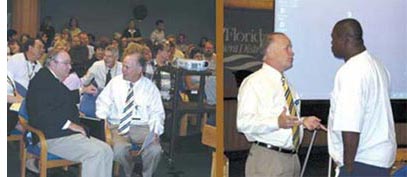 Left photo: David Moore, executive director, and Jerry Rice, Governing Board chair, chat before an employee meeting in Brooksville. Right photo: David Moore, executive director, answers a question from Malcolm Hudson, senior tradesworker, between employee meetings in Brooksville.
Left photo: David Moore, executive director, and Jerry Rice, Governing Board chair, chat before an employee meeting in Brooksville. Right photo: David Moore, executive director, answers a question from Malcolm Hudson, senior tradesworker, between employee meetings in Brooksville.
In May, the District’s Governing Board recognized two staff members for their roles on a successful restoration project that received national recognition.
Mark Brown, District senior environmental scientist, and Paul Miselis, senior environmental engineer, were recently presented with the 2005 Coastal America Partnership Award for their work on the Fort DeSoto Ecosystem Restoration Project. The two also received a congratulatory letter from President Bush, commending them for their hard work and dedication to conserving our coastal environment.
The project, which is a cooperative effort among Pinellas County, the District’s Pinellas-Anclote River Basin Board and the District’s Surface Water Improvement and Management (SWIM) program, restored the natural flow of water between two back bays at Fort DeSoto Park near the mouth of Tampa Bay. Restoring the circulation will help improve water quality and habitats in the estuary. Restoring Tampa Bay is the top priority for the District’s SWIM program.
When the park was being developed during the late 1950s and early 1960s, a dredge-and-fill project connected a series of small mangrove islands from the mainland to a barrier island. This causeway allowed visitors better access to the Fort DeSoto beaches, but it cut off the flows in the back bays, which impaired water quality and caused a loss of seagrass.
The new 40-foot bridge, built over an area that was historically open water, has increased the exchange of water between two relatively stagnant back bays.
Stormwater runoff from the new sections of roadway is also receiving water quality treatment before it is discharged into the bay.
“The project is unique because it allows the nearly 2 million people who visit the park each year a first-hand opportunity to view a water quality and habitat improvement project,” said Miselis, who was the project manager on this SWIM program project.
The project cost $1.75 million to complete. Part of the funding was provided as mitigation for impacts from Florida Department of Transportation (FDOT) road construction projects. Because of these impacts, the District’s Governing Board was able to contribute $120,000 in FDOT mitigation funds. The District’s Pinellas-Anclote River Basin Board contributed $166,500 and the District’s SWIM program contributed $249,750 to the project.
“This project is an example of how the FDOT mitigation program can provide funds toward conducting regionally significant enhancement and restoration of native habitat,” said Brown.
FDOT and five other agencies — U.S. Fish and Wildlife Service, National Oceanic and Atmospheric Administration, U.S. Department of Commerce, U.S. Environmental Protection Agency Gulf of Mexico Program and Pinellas County Environmental Fund — also contributed to the project.
